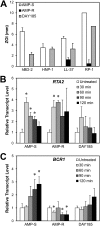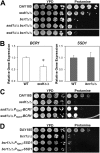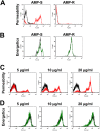Bcr1 functions downstream of Ssd1 to mediate antimicrobial peptide resistance in Candida albicans
- PMID: 23314964
- PMCID: PMC3629773
- DOI: 10.1128/EC.00285-12
Bcr1 functions downstream of Ssd1 to mediate antimicrobial peptide resistance in Candida albicans
Abstract
In order to colonize the host and cause disease, Candida albicans must avoid being killed by host defense peptides. Previously, we determined that the regulatory protein Ssd1 governs antimicrobial peptide resistance in C. albicans. Here, we sought to identify additional genes whose products govern susceptibility to antimicrobial peptides. We discovered that a bcr1Δ/Δ mutant, like the ssd1Δ/Δ mutant, had increased susceptibility to the antimicrobial peptides, protamine, RP-1, and human β defensin-2. Homozygous deletion of BCR1 in the ssd1Δ/Δ mutant did not result in a further increase in antimicrobial peptide susceptibility. Exposure of the bcr1Δ/Δ and ssd1Δ/Δ mutants to RP-1 induced greater loss of mitochondrial membrane potential and increased plasma membrane permeability than with the control strains. Therefore, Bcr1 and Ssd1 govern antimicrobial peptide susceptibility and likely function in the same pathway. Furthermore, BCR1 mRNA expression was downregulated in the ssd1Δ/Δ mutant, and the forced expression of BCR1 in the ssd1Δ/Δ mutant partially restored antimicrobial peptide resistance. These results suggest that Bcr1 functions downstream of Ssd1. Interestingly, overexpression of 11 known Bcr1 target genes in the bcr1Δ/Δ mutant failed to restore antimicrobial peptide resistance, suggesting that other Bcr1 target genes are likely responsible for antimicrobial peptide resistance. Collectively, these results demonstrate that Bcr1 functions downstream of Ssd1 to govern antimicrobial peptide resistance by maintaining mitochondrial energetics and reducing membrane permeabilization.
Figures








Similar articles
-
SSD1 is integral to host defense peptide resistance in Candida albicans.Eukaryot Cell. 2008 Aug;7(8):1318-27. doi: 10.1128/EC.00402-07. Epub 2008 May 30. Eukaryot Cell. 2008. PMID: 18515753 Free PMC article.
-
Identification of genes upregulated by the transcription factor Bcr1 that are involved in impermeability, impenetrability, and drug resistance of Candida albicans a/α biofilms.Eukaryot Cell. 2013 Jun;12(6):875-88. doi: 10.1128/EC.00071-13. Epub 2013 Apr 5. Eukaryot Cell. 2013. PMID: 23563485 Free PMC article.
-
Characterization of biofilm formation and the role of BCR1 in clinical isolates of Candida parapsilosis.Eukaryot Cell. 2014 Apr;13(4):438-51. doi: 10.1128/EC.00181-13. Epub 2013 Dec 2. Eukaryot Cell. 2014. PMID: 24297446 Free PMC article.
-
The NDR Kinase Cbk1 Downregulates the Transcriptional Repressor Nrg1 through the mRNA-Binding Protein Ssd1 in Candida albicans.Eukaryot Cell. 2015 Jul;14(7):671-83. doi: 10.1128/EC.00016-15. Epub 2015 May 22. Eukaryot Cell. 2015. PMID: 26002720 Free PMC article.
-
Emerging Mechanisms of Drug Resistance in Candida albicans.Prog Mol Subcell Biol. 2019;58:135-153. doi: 10.1007/978-3-030-13035-0_6. Prog Mol Subcell Biol. 2019. PMID: 30911892 Review.
Cited by
-
Interplay between Candida albicans and the antimicrobial peptide armory.Eukaryot Cell. 2014 Aug;13(8):950-7. doi: 10.1128/EC.00093-14. Epub 2014 Jun 20. Eukaryot Cell. 2014. PMID: 24951441 Free PMC article. Review.
-
Fungal Strategies to Evade the Host Immune Recognition.J Fungi (Basel). 2017 Sep 23;3(4):51. doi: 10.3390/jof3040051. J Fungi (Basel). 2017. PMID: 29371567 Free PMC article. Review.
-
Innate Immunity to Mucosal Candida Infections.J Fungi (Basel). 2017 Oct 31;3(4):60. doi: 10.3390/jof3040060. J Fungi (Basel). 2017. PMID: 29371576 Free PMC article. Review.
-
Various Biomimetics, Including Peptides as Antifungals.Biomimetics (Basel). 2023 Oct 28;8(7):513. doi: 10.3390/biomimetics8070513. Biomimetics (Basel). 2023. PMID: 37999154 Free PMC article. Review.
-
Oropharyngeal Candidiasis: Fungal Invasion and Epithelial Cell Responses.PLoS Pathog. 2017 Jan 12;13(1):e1006056. doi: 10.1371/journal.ppat.1006056. eCollection 2017 Jan. PLoS Pathog. 2017. PMID: 28081240 Free PMC article. Review. No abstract available.
References
-
- Yount NY, Yeaman MR. 2012. Emerging themes and therapeutic prospects for anti-infective peptides. Annu. Rev. Pharmacol. Toxicol. 52: 337– 360 - PubMed
-
- Meiller TF, Hube B, Schild L, Shirtliff ME, Scheper MA, Winkler R, Ton A, Jabra-Rizk MA. 2009. A novel immune evasion strategy of Candida albicans: proteolytic cleavage of a salivary antimicrobial peptide. PLoS One 4: e5039 doi:10.1371/journal.pone.0005039 - DOI - PMC - PubMed
-
- Szafranski-Schneider E, Swidergall M, Cottier F, Tielker D, Roman E, Pla J, Ernst JF. 2012. Msb2 shedding protects Candida albicans against antimicrobial peptides. PLoS Pathog. 8:e1002501 doi:10.1371/journal.ppat.1002501 - DOI - PMC - PubMed
Publication types
MeSH terms
Substances
Grants and funding
LinkOut - more resources
Full Text Sources
Other Literature Sources

